
Jerry Burke and Mark Benson share a lot more than their business interests: Mark is also Jerry’s son-in-law. Despite that, these two woodworkers get along famously in their Dresser, Wisconsin furniture business. They manage to keep domestic matters out of the workshop and insist that, at least from nine to five, their family tree is a Norway pine.
Mark harvests straight Norway logs from a commercial tree farm a few miles north of the shop. He likes to do this in fall and winter, when humidity levels are low and insect activity is at a minimum. He looks for tall, straight growth that will yield two or three eight-foot logs. Trunks must be a uniform diameter throughout the length of the log, so he looks for trees that have grown close together and have had to compete for sunlight
The logs are brought back to the shop for peeling and air drying. Their bark is peeled outdoors with a drawknife, then they’re stored vertically indoors until they’re dry enough to use. As most pieces of log furniture call for several small elements (handles, bracing etc.), almost every piece of the tree is used in the building process. Then the residual bark and needles are simply returned to the soil.
Not Just Logs
Jerry and Mark started their business in April ’96, in rented space that they quickly outgrew. In the spring of ’98, they purchased the Dresser building, a superb commercial site on a main tourism highway. Since then, The Pine Mill has expanded its offerings to include picture framing, a service that naturally complements their log furniture line. Aside from traditional frames made with premanufactured stock moldings, Jerry and Mark also frame a wide variety of stock wildlife and customer prints using more natural materials like pine saplings and recycled barnwood. Picture framing has quickly grown in popularity with their customers, and now comprises about 20 percent of their trade.
Learn as You Go
When Mark and Jerry first began building with logs, they discovered just how much they didn’t know. Over the years they’ve learned that cutting a better dado is a matter of using an old-fashioned pullsaw and a chisel (instead of resorting to a radial arm saw). Despite the fact that their shop is relatively well-equipped with power tools, they still do most of their work by hand. Jerry says his customers appreciate that rustic, craftsmanlike approach to building.
The years have also taught them a lot about their customers. It seems that most people like furniture built with larger logs, and opinions are pretty much split as to whether the logs should be straight and clean or uniquely natural. After several experiments, they have decided that water-based brushed finishes do the pine the most justice: they dry quickly, develop a sun-dried patina in a short period of time, and are easy to apply.
While many of their pieces are speculative and destined for the showroom, some of their best work has been custom built. For example, one of their earliest commercial jobs was an order for ten different beds and nightstands to furnish a new bed and breakfast in nearby Duluth, MN. They’ve also done their share of coffee shop bar stools and tables, along with numerous residential pieces.
Expansion Planned
The future looks pretty rosy for these old-fashioned woodworkers. They plan to expand the current shop this year, giving themselves a larger workshop, more log storage and an expanded showroom. They’re also planning to hire their first employee this year, but they both insist that won’t change the shop’s intimate character. All in all, this is one family tree that seems to be growing straight and true.





